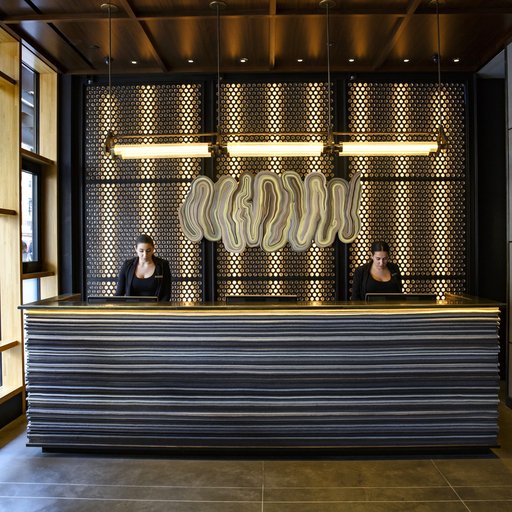This interview with new Armory Show director Ben Genocchio is part of our cover feature "Auctions vs. Art Fairs: Behind the Battle for Your $$$," in which Genocchio and Christie's evening sale head Sara Friedlander explain the virtues of their particular art-market models.
This year, as the Armory Show returns for its latest edition, the auction houses will be simultaneously angling for collectors with a suite of lower-priced contemporary sales, both physical and online. Christie’s has First Open, Sotheby’s has Contemporary Curated. With buyers coming to New York from around the world, how would you describe the chief offer that the Armory Show presents?
The variety of offerings—this year’s edition has 205 exhibiting galleries from 36 countries and more than 1,500 artists. This kind of scope and scale is unparalleled outside of the art-fair model; it gives collectors more choice and a greater spectrum with regard to price. For dealers, the sheer number of visitors at the Armory Show is an enormous offering, with between 60,000 to 80,000 attendees passing through the fair in five days. Apart from Art Basel Miami Beach, the Armory Show is the best-attended fair in North America—and with 36 countries represented, it’s the most international in the world.
How does that compare with what they can find at the auctions?
It’s a matter of preference for buyers. Overall, auctions tend to be more random selections from different times, places, and points in an artist’s career, often featuring just a single example of an artist’s work. Fairs tend to draw more focused presentations, often with more than one work by an artist and usually spotlighting a specific moment in their career. You also have many dealers with different pieces by the same artist, so you can shop and compare quality and prices.
How would you describe the audience that comes to the Armory Show?
We have an enormous audience and it is very difficult to generalize as it runs the gamut from major collectors and art-buying celebrities on the VIP Preview day to families and school groups on weekends. That said, given our location in Manhattan, it means our visitors are engaged art enthusiasts with serious collecting power. We are also not a ‘one-day’ fair, which means our VIPs and collectors come back—and sometimes back a third time—to shop. This is in part because of our size and easy accessibility at the Piers.
Everyone says the market is more cautious this year. Why should collectors itching to buy reserve their funds for the Armory Show?
Buying from a dealer at a gallery or a fair is overall a more rewarding experience for most collectors. They meet the dealer, discuss the work, and can often meet the artist at some point, if they wish. Buyers can negotiate directly and privately on the price, meaning there is more flexibility. There’s also more contact with artists, art critics, and people who share the same taste and values, so there is a stimulating social dimension to consider. On average, live auction sales of artwork usually take about one minute to complete.
One distinction that the auction houses advertise is that everything that happens in their sales occurs out in the open, with listed prices and incentives, like guarantees, publicly disclosed. Art fairs, they might say, have less transparency, with dealers offering different prices to different buyers. As someone who has extensively covered both marketplaces, how would you describe the reality of the situation?
I think everyone knows that the large auction houses are in no way entirely transparent, and that the kind of transparency they have is limited to what is mandated by law—I am talking about the public declaration of third-party guarantees and other complex financial arrangements that now surround high-end auction transactions. But the fact that the auction house represents both the buyer and the seller in the transaction poses a serious problem. This is very much to the detriment of the buyer.
Auction house premiums are significant, if not unjustified, and should not be overlooked when discussing this. An auction house will typically charge a buyer between 15 and 20 percent—and up to 25 percent—to participate in a sale. This seems like an unreasonable and unsustainable model. Meanwhile, when you buy from a dealer you are offered an artwork at a price that you can choose to pay or not, or you can choose to negotiate with the dealer for what you believe is a fair price. You can also use databases like Artnet to compare previous sale prices at auction or visit and consult other dealers.
I believe there is far greater transparency in the gallery market for those who are willing to use the available tools and educate themselves.
What about at the younger end of the market? We just went through an overheated phase of fly-by-night market booms and subsequent busts, bookended on one side by Katya Kazakina’s famous proclamation of 3,000-percent returns and the ongoing backlash against “Zombie Formalism” on the other. In a flipping marketplace, auctions are the ultimate way to cash in before a market craters. Why are fairs smarter places to buy young art?
Buying young artists to flip their work for profit is not something I endorse or condone. The bottom line is that it’s like buying a high-risk speculative asset, so in my view it doesn’t really matter so much where you buy their work–at auction, or through a dealer at an art fair. What matters is when you sell. Fairs are always great places to sell because people come to fairs with a predisposition to buy.
If you’re someone with an interest in speculation and art as investment, where can you get a better alpha: auctions or fairs?
It really depends on the artist and the work. Auctions seem to support good prices for extremely ‘hot’ or in-demand artists, but then again the work of those sorts of artists also sells very well at art fairs. Fairs also support much better prices for work by artists who are not necessarily hot or in huge demand, because buyers have more time and space to learn about the artist—they’re frequently able to view multiple examples of an artist’s work and build a relationship with the dealer, who is very often knowledgeable on the subject. But, in the end, it often comes down to a difference of whether or not you are prepared to pay a fixed asking price and negotiate or compete with other buyers financially for the privilege to own a work.
BESbswyBESbswyBESbswyBESbswyBESbswyBESbswyBESbswyBESbswyBESbswyBESbswyBESbswyBESbswyBESbswyBESbswyBESbswyBESbswy
How would you describe the competition between fairs and auctions?
Each has its own value based around a very different kind of event, in its own space, delivering different opportunities to art buyers. Smart buyers should access both opportunities based on the artists and work they are interested in. Auction houses are now taking cues from art fairs, trying to create an ‘event’ out of the traditional auction experience with multi-day and multi-dimensional sales, with a greater volume of work offered at different price points, online and off. They are attempting to compete with the art-fair model and satisfy the market’s interest in event-based buying experiences. I’m not sure it will work to try to compete directly with fairs in this way, because much of the inventory for auctions is locked up with the dealers—either as stock or with their own consigning clients.
I know fairs like Basel have agreements in place to prevent auction specialists from hunting among their aisles—is that the case at the Armory too? Why or why not?
We don’t have agreements like this. Business is business.
At contemporary fairs, the art is often fresh from the studio and therefore not vetted by history, whereas auctions specialize in secondary-market work that has provenance and even exhibition track records. Where would you say the quality of the work is higher, on average: auctions or fairs?
It depends on the auction and the fair. I have also seen auction houses increasingly getting involved in selling primary-market work, and so this distinction is eroding.
What are the chief downsides to buying at auction?
The premiums—the pay-to-play.
On the other hand, what are the chief downsides of art fairs?
The crowds.
Some might say the conspicuous consumption at these events has reached unhealthy heights—for instance, during the last Art Basel Miami Beach, Artnet wrote that that fair “openly fostered a glorification of wealth and a culture of envy and excess” to a degree that it “must in some way have contributed to a climate where a crazed individual felt it acceptable to stab someone.” Do art fairs need to be like that, and if not, how can they change?
I didn’t write that—it was from an outside contributor. Miami is a city that trades on an art fair, not the other way around. I find people are mostly interested in partying first and looking at art later. If you are a serious collector going to Miami, you’re in and out before the first hotel pool party has emptied out.
Where are other places that art fairs like the Armory could evolve to better cater to buyers’ needs?
Art fairs need to continue to evolve on this front in order to keep up with the evolving needs of the dealers and collectors. For example, this year we are introducing a private viewing room, sponsored by Dietl. We’ve already gotten a tremendously positive response from dealers. In the future we’re looking into more storage, so dealers can bring more works and collectors can come back once, or twice, and still see fresh work. Longer preview hours would also give dealers and collectors more time with artworks.
What do you think are some of the best buys at the Armory Show this year?
That depends on what you’re looking for. The great thing about our fair is the spectrum of prices you can find, from emerging artists in the $10,000 range to multimillion-dollar works. Praz-Delavallade will be bringing an exquisite series of Matthew Brandt photographs, there’s a Frank Bowling solo booth at Hales Gallery, Larry Poons and John Chamberlain at Danese & Corey, Sylvie Fleury and Robert Longo at Galerie Thaddaeus Ropac, Tracey Emin at Galleria Lorcan O’Neill, William Copley at Paul Kasmin. And from the younger, more emerging set, Toyin Ojih Odutola at Jack Shainman and Raphael Hefti at RaebervonStenglin and Julian Charriere at Dittrich & Schlectrium.



























